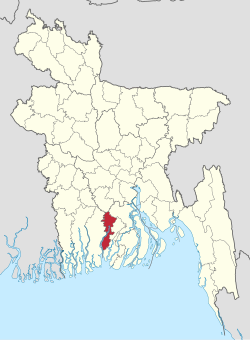Pirojpur
|
Pirojpur 1984 পিরোজপুর |
|
|---|---|
| District | |
| 1984 in Bangladesh | |
| Coordinates: 22°35′N 89°58′E / 22.58°N 89.97°ECoordinates: 22°35′N 89°58′E / 22.58°N 89.97°E | |
| Country |
|
| Division | Barisal Division |
| Area | |
| • Total | 1,399.39 km2 (540.31 sq mi) |
| Population (2011 census) | |
| • Total | 1,113,257 |
| • Density | 800/km2 (2,100/sq mi) |
| Time zone | BST (UTC+6) |
| Postal code | 8500 |
Pirojpur (Bengali: পিরোজপুর) is a district (zila) in south-western Bangladesh. It is part of Barisal Division.
According to myth, the second son of Shah Shuja, Firoz Shah, died in this area, and the area became known subsequently as 'Firozpur'. In time, the pronunciation 'Firozpur' slowly muted to 'Pirozpur'.
Pirojpur District had a population of 1,113,257 at the 2011 Census (provisional).
Most of the land is low-lying and the soil is fertile. There are small forests.
Nesarabad is known for its business centre and also for the Sundori tree (a kind of mangrove) that grows there.
Launches, steamers and boats are used for travelling on the rivers. The local port is called Hoolarhaat Launch Station (ghaat). Buses, autorickshaws and rickshaws are also used for transport.puraton bus station is on of the most popular place of this district.
Pirojpur District is bordered by Barisal and Gopalganj districts to the north, Barguna district to the south, Jhalokati and Barguna districts to the east, Bagerhat district and the Sundarban, the largest mangrove forest to the west.
The subdivision (then, a mohokooma, now a zila) of Pirojpur was created in 1866. Pirojpur district was formed in 1984 and the Municipality was formed in 1886. The area of Pirojpur is 1399.39 km2. It is under Barisal Division. There are 4 Municipalities in Pirojpur named Pirozpur, Bhandaria, Nesarabad and Mathbaria. The number of Upazilas (sub districts) in Pirojpur district is 7, named- Pirojpur Sadar, Bhandaria, Mathbaria, Zianagor, Nazirpur, Sharupkathi and Kaukhali. Of the seven upazilas of the district Mathbaria is the largest (353.25 km2, it occupies 27.01% of the total area of the district) and Kawkhali is the smallest (79.65 km2). It also containing 51 Unions, 390 Mauzas and 648 Villages.
...
Wikipedia

